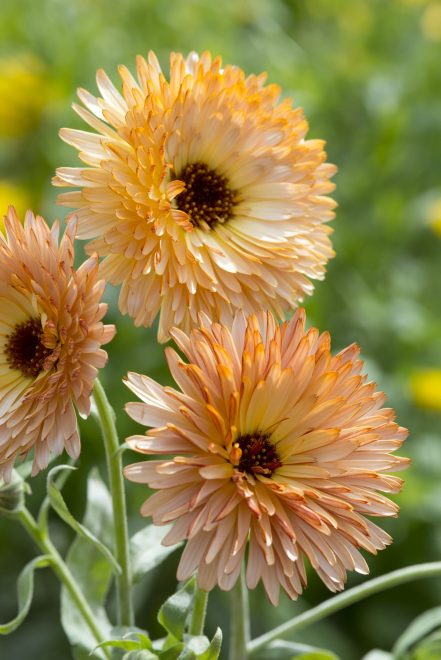Calendula – A gardener’s dream!
Published 10:20 am Thursday, June 5, 2025

- ORANGE YOU GLAD I'M IN THE GARDEN: The Orange Flash contains large blooms in peach and cream with a bronze center. (National Garden Bureau)
“It’s beautiful, the summer month of June, and the sun shines most of the day brightly.” – Francis Duggan.
“This is the smell of June, honeysuckle, green hay, wet linen hung out to dry.” – Lisa Kleypas.
“June has never looked more beautiful than she does now, unadorned and honest, vulnerable yet invincible.” – Marie Lu.
Trending
“Summer afternoon… summer afternoon; to me those have always been the two most beautiful words in the English language.” – Henry James.
“June is the time for dreams to take flight and soar into reality.” – Emma Racine de Fleur.
“Green was the silence, wet was the light, the month of June trembled like a butterfly.” – Pablo Neruda.
Calendula, a radiant bloom with a rich historical tapestry dating back to ancient Egypt, has long been revered for its dual virtues of medicinal prowess and aesthetic allure. Learn more about this versatile plant that thrives in various conditions, making it a gardener’s dream.
Initially cherished by the Egyptians for its healing properties and beauty, Calendula found its way to Europe through Roman influence, swiftly gaining popularity as both a therapeutic herb and an ornamental gem.
Native to the sun-kissed Mediterranean region, Calendula has transcended borders to become a global favorite among gardeners, thanks to its resilient nature that thrives in diverse environments. Its name, derived from the Latin “calendae,” symbolizes its perpetual blooming cycle, with fresh blossoms unfurling each month in a vibrant display of nature’s artistry.
Trending
Calendula petals, beyond their visual splendor, serve as a source of yellow dye, earning the flower the endearing moniker “poor man’s saffron” for its ability to mimic the prized hue of saffron. This versatile plant not only graces gardens with its beauty but also offers practical applications in dyeing and culinary pursuits.
Some of the many Calendula varieties include Ball’s Orange – large, fully double, orange flowers that grows to 24 inches tall, Bon Bon – dwarfed 12-inch tall bushy calendula mounds with dense 2-3 inch fully doubled golden pom-pom bulbs, and Bull’s Eye – overlapping petals like a bird’s feathers, closely arranged in a circular swirl around a chestnut center.
Also, Calexis – double cactus flowers with rolled petals in striking colors around a contrasting dark brown center, Candyman Orange – large, fully double flowers with a deep orange color sturdy dwarf 10-12″multi-branched stems, Costa series – dwarf and compact multi-branched plants with light yellow, orange, and yellow flower color.
Also, Fieldgrown Mix – single and double mix in a complete color range, Fiesta Gitana – a dwarf variety that grows 8 to 12 inches tall and comes in shades of orange, yellow, and gold, Firecracker – unique apricot-colored spiky petals are reminiscent of chrysanthemum blooms, Kablouna – striking crested mostly yellow blooms with dark contrasting centers, Kablouna Luna – stunning plant showcases Kablouna-type flowers with creamy blooms adorned with vibrant orange tips, and Kinglet – a new variety with crested petals in lemon, apricot, and mandarin.
Also, Neon – ultra-double brilliant orange flowers, edged in burgundy, Porcupine Series – distinctive quilled with yellow or orange petals, Oopsy Daisy – compact mix of single and semi-double flowers that are tipped in orange, Orange Flash – large blooms in peach and cream with a bronze center, Pacific Beauty Mix – semi-double to double blooms in yellow, orange and gold, and Pygmy Buff – double two-tone buff flowers with a mahogany reverse on the petals.
And Solar Flashback – copper, pink, and yellow bicolored flowers with solid red or maroon backs, Sunset – sunset hues in apricot and red petals, Touch of Red – deep bronze and red edges and backs of each petal, and Zen – gold and yellow flowers on compact plant.
Calendula grows easily in full sun in any regular garden soil and thrives in a pH range of 5.5-7.0. Pinch back young plants to encourage bushy growth. Occasional feeding is rewarded, but unnecessary. Keep plants watered but avoid overhead watering as plants are susceptible to mildew. Deadhead regularly to prevent self-sowing and continual blooms. It does best in cool weather and may stop blooming in mid-summer heat. It will likely start to bloom again in the cooler weather.
Calendula gardening tips: Sun seeker – Grant your Calendula at least 6 hours of daily sunshine to witness its radiant blooms unfurl. Finding the perfect soil – Well-draining soil is key. While Calendula isn’t fussy about soil type, it prefers a slightly acidic to neutral pH. Planting for success – Sow seeds directly outdoors after the last frost. Space them 12-18 inches apart for ample room to flourish. The secret to continuous blooms – Regularly remove spent flowers (deadheading) to encourage new growth. This keeps your plant looking tidy and stimulates more blooms.
Natural pest control- Calendula is naturally resistant to pests, but keep an eye out for occasional visitors like aphids or caterpillars. Garden harmony – Plant Calendula alongside tomatoes and beans! It acts as a natural pest deterrent, attracting beneficial insects to your garden. Harvesting your bounty – Pick Calendula flowers when fully open, preferably in the morning for the most concentrated oils. Dry them for later use in teas, salves, or potpourri.
Bonus tips for the discerning gardener – Edible delight – Surprise your palate! Calendula flowers are edible with a subtle peppery flavor, adding a vibrant touch to salads, soups, and stews. DIY Potpourri – Dried Calendula blossoms infuse your space with a beautiful fragrance. And soothing salves – Calendula’s calming properties make it a popular ingredient in homemade salves.
“For we are God’s workmanship, created in Christ Jesus to do good works, which God prepared in advance for us to do.” Ephesians 2:10. “You will seek Me and find Me when you seek Me with all your heart.” Jeremiah 29:13. “Call to Me and I will answer you and tell you great and unsearchable things you do not know.” Jeremiah 33:3. “Do you not know? Have you not heard? The Lord is the everlasting God, the Creator of the ends of the earth. He will not grow tired or weary, and His understanding no one can fathom. He gives strength to the weary and increases the power of the weak.” Isaiah 40:28-29. “Since we live by the Spirit, let us keep in step with the Spirit.” Galatians 5:25.





